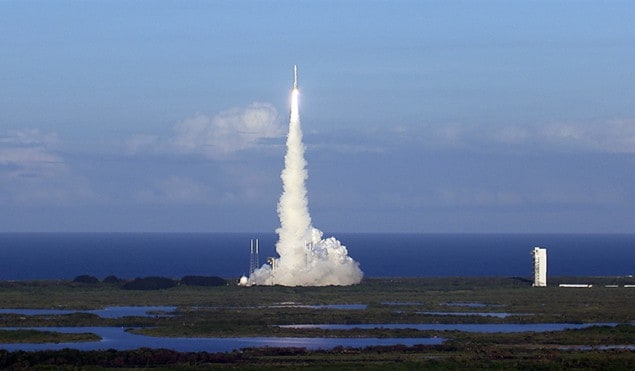
NASA has launched the first US mission to take samples from an asteroid and return them to Earth. The $1bn Origins-Spectral Interpretation-Resource Identification-Security-Regolith Explorer (OSIRIS-REx) took off yesterday from Cape Canaveral in Florida at 19:05 local time aboard an Atlas V rocket. It now begins a two-year journey to the asteroid Bennu, where it will aim to gather around 60 g of dust, soil and rubble from the body and return it to Earth.
Weighing 1500 kg, OSIRIS-REx’s main aim is to measure the abundance and types of organic materials that make up asteroids. This could give researchers a better understanding of how life began on Earth. Bennu, which was discovered in 1999, is an ideal target as it was supposed to have formed at the same time as the Earth. It is a chunk of dust and rubble around 500 m in diameter that is thought to be rich in carbon and organic molecules.
“This represents the hopes and dreams and blood, sweat and tears of thousands of people who have been working on this for years,” says Dante Lauretta from the University of Arizona, who is principal investigator for OSIRIS-REx. “I can’t tell you how thrilled I was thinking of the people who played a part in this.”
Extending an arm
Once OSIRIS-REx arrives at Bennu in 2018, it will spend a couple of years surveying the body using its five instruments – three spectrometers, a camera suite and a laser altimeter – to select a suitable site for sampling. The craft will then carefully approach the asteroid – although never actually landing on it – and extend a 3.3 m arm that will fire nitrogen gas at the surface. This jet will break off samples that the probe will collect to return to Earth in 2023.
OSIRIS-REx will also attempt to measure – for the first time – the force acting on a rotating body in space caused by photons. Known as the “Yarkovsky effect”, after the Russian civil engineer Ivan Osipovich Yarkovsky, it is a result of the asteroid absorbing sunlight and then re-emitting it as heat. A better understanding of the effect will let scientists more accurately predict the path of an Earth-approaching asteroid. “The knowledge from the mission will help us to develop methods to better track the orbits of asteroids,” notes Jim Green, director of NASA’s planetary science division.
If successful, OSIRIS-Rex is set to become the third mission to return a sample of an asteroid to Earth. In 2010 the Japanese Space Agency’s Hayabusa mission returned around 15,000 “grains” from the Itokawa asteroid. In 2014 Japan launched Hayabusa 2, which will aim to return samples from asteroid 1999 JU3 – an almost spherical carbon-rich asteroid that is 920 m in diameter and is thought to contain organic matter and hydrated minerals – by 2020.
NASA also hopes that the mission will demonstrate advanced imaging and mapping techniques that will be required for future science missions, as well as upcoming commercial asteroid-mining trips. Indeed, just last month Deep Space Industries announced the firm’s first commercial mining mission. Prospector-1, which is planned to launch around the end of the decade, will monitor an asteroid close to Earth and land on it to determine the body’s hardness and other geological characteristics.



